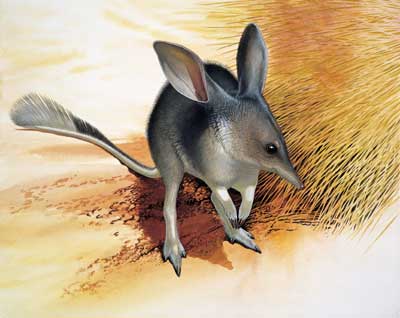
Lesser Bilby (Macrotis leucura)
Distribution: Central Australia.
Last Record: 1950s.

The lesser bilby was an inhabitant of Australia’s driest deserts, and recorded as a living animal on just a handful occasions between its discovery in 1887 and its extinction in the 1950s. It seems to have been moderately abundant on Cooncherie Station in the summer of 1932, where Hedley Herbert Finlayson collected a dozen specimens. These were all caught by an Aboriginal helper who ‘seldom returned without 2 or 3 after a morning’s work and I suspect many found their way to the cooking fires as well’. These were, however, the last to be collected alive.
Unlike most members of the bandicoot group to which it belongs, the lesser bilby was a carnivore, and native rodents were recorded among its prey. And unlike the gentle and still surviving common bilby, it had a nasty temperament. Finlayson noted it was ‘fierce and intractable, and repulsed the most tactful attempts to handle them by repeated savage snapping bites and harsh hissing sounds’. It burrowed only in sand dunes, constructing burrows two or three metres deep, closing the entrance with loose sand by day. It was strictly nocturnal, twins were standard, and reproduction may have been non-seasonal.
The last recorded specimen consists of a skull picked up below a wedgetailed eagle’s nest by P. Hanisch at Steele Gap in the Simpson Desert, Northern Territory, in 1967. The bone was still relatively fresh, and was estimated to be less than fifteen years old.